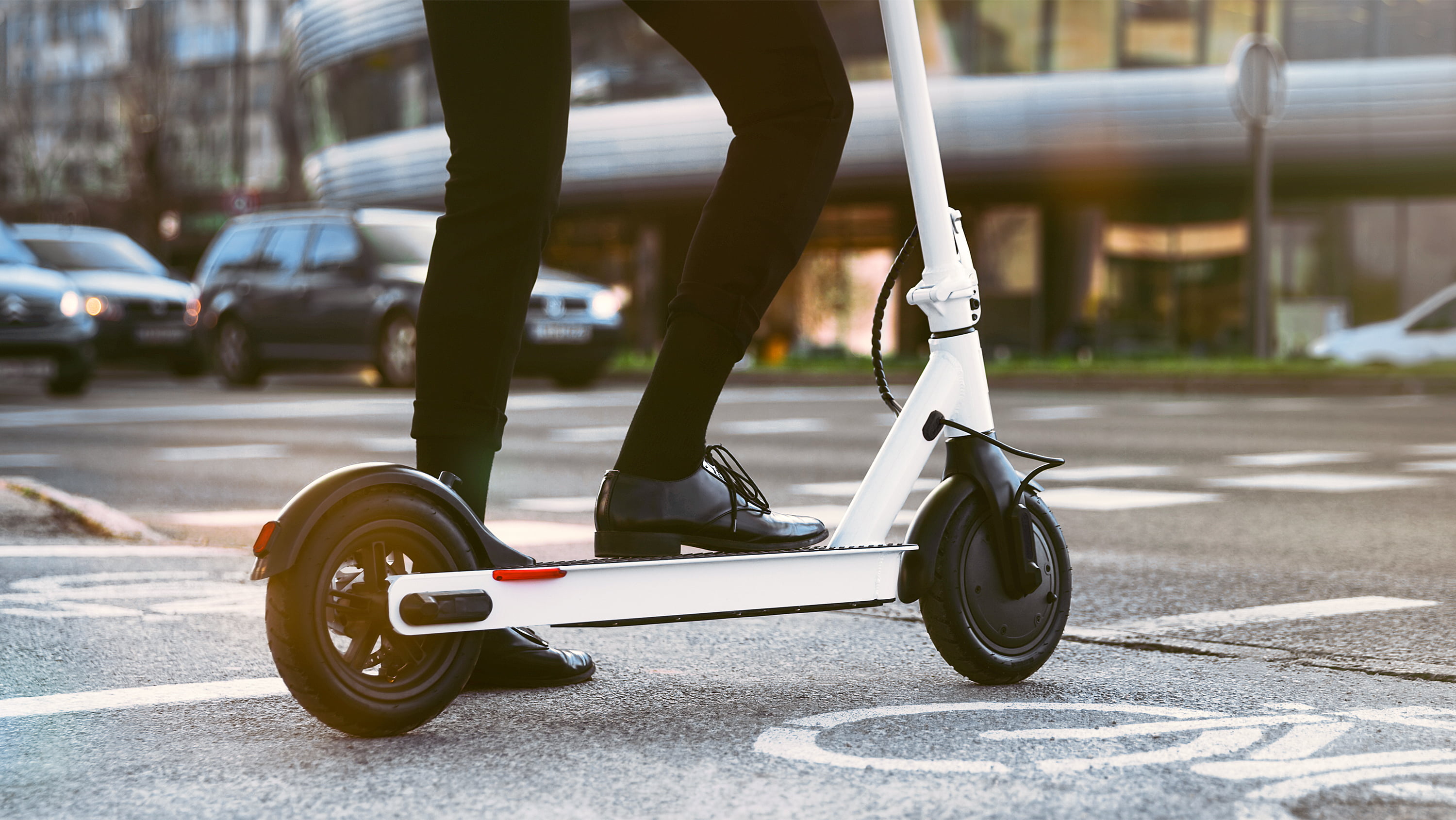As the popularity of electronic scooters (also called e-scooters) skyrockets, University of Alberta safety experts are hoping to slow the accompanying rise in injuries by advocating for better regulation and rider education.
People in Edmonton hopped onto rental e-scooters more than a million times in 2023 according to city data, while more than 800 riders wound up in emergency departments with injuries according to numbers provided by Alberta Health Services to the media. Both statistics are roughly double what they were in 2022.
“The number of e-scooters has gone up significantly since they were first introduced in 2017, and I only see that getting larger because especially young people are going to look for easier ways to get around,” says Kathy Belton, director of the U of A’s Injury Prevention Centre and adjunct professor in the School of Public Health.
“The problem is there are no consistent safety rules and the ones that do exist are not enforced,” Belton says. “It’s like the Wild West.”
Belton teamed up with emergency physician and professor Brian Rowe to carry out an observational study of e-scooter use in Edmonton this summer, tracking more than 2,000 trips and interviewing 200 riders. They hope to gain insight into the injury statistics Rowe and his team uncovered by looking at emergency department records for three summers, from 2019 to 2021.
Of 759 adult patients, 20 per cent arrived by ambulance and 62 per cent had multiple injuries, mostly to upper and lower limbs and the head. While only six per cent were admitted to hospital, nine per cent needed surgery. Only two per cent reported wearing a helmet, and alcohol or substance use was suspected in 25 per cent of the cases.
Three companies currently rent e-scooters in Edmonton, part of a pilot project allowed by an exemption under the Alberta Traffic Safety Act in Airdrie, Lethbridge, Medicine Hat, Okotoks, Red Deer, Leduc, Edmonton and Calgary. Private scooters are technically illegal throughout the province, but the minister of transportation is expected to update the rules this fall.
In the meantime, it’s up to each municipality to develop their own bylaws for e-scooters, leading to confusion for users. For example, you’re not allowed to ride on the sidewalks in Edmonton, but you are in Red Deer and St. Albert. As for enforcement, it’s almost nonexistent. Most municipalities have focused on education instead. The City of Edmonton reports handing out just 14 tickets during a blitz in 2021 and no tickets at all in the other four years of the rental program.
“We injury prevention people are given the label of being naysayers, but it’s not like I have a vested interest in shutting down tourism or fun in Edmonton or Alberta,” says Rowe, who is director of the Emergency Medicine Research Group (EMeRG) in the Faculty of Medicine & Dentistry. “We’re just trying to make riding an e-scooter safer.”
A big piece of the puzzle, Belton and Rowe believe, is getting the word out to riders about how to operate e-scooters more safely. Here are their top tips.
Don’t use your child as an airbag
Even though non-electric scooters were originally invented for children, your child should never be on an e-scooter, either alone or with you. Use of e-scooters is restricted to people over the age of 18, and they are meant for just one rider at a time.
“We’re seeing parents on the back and kids on the front. That’s just a recipe for disaster because if they crash, not only is the child going to hit whatever they crash into, they’re going to have a secondary impact of the parent crashing into the child,” says Belton. “It’s almost like parents are using their children as airbags.”
“What we’ve observed on the roadside surveys is a lot of parents allowing their children to operate rental scooters, as well as riding double with their young children in front of them,” says Rowe. “These are very high risk behaviours.
“E-scooters are for a single user with both hands on the handlebars.”
Protect your noggin
Seventeen per cent of the cases in Rowe’s emergency department chart review had head injuries, while only two per cent reported wearing a helmet at the time of their fall.
St. Albert is the only jurisdiction in Alberta where everyone, regardless of their age, must wear a helmet when they ride a bike or an e-scooter, but helmets are recommended throughout the province.
“I’m an emergency physician and I’ve seen many head injuries, and I know the people who wear helmets have a much better chance of surviving and being cognitively intact after a crash than somebody who doesn't have a helmet, and that’s on bikes, ATVs, motorcycles, you name it,” says Rowe.
Only one rental company in Edmonton provides a helmet with each e-scooter, but even so only 10 per cent of people use them because of what Belton calls the “ick factor.” She points out that the worst-case scenario from sharing a helmet — lice — is a lot less serious than a head injury.
Rowe won’t use an e-scooter because he says it’s more dangerous than his preferred mode of transport: cycling. He rides his bicycle to and from work daily. He points out that even if you feel like you’re a safe driver yourself, the risk comes from others who may not have such good judgment or control. And they may be in a much bigger vehicle than you are.
Plan your route
Rowe rides his bicycle almost exclusively on bike lanes and shared-use paths, and he suggests everyone does the same on an e-scooter. E-scooters are permitted on roads with a speed limit of 50 km/h or less within Edmonton city limits. Whyte Avenue between 112th and 97th streets is an exception, where you’re not allowed to ride or park an e-scooter or an e-bike.
Even at low speeds, Rowe says it isn’t worth it to be on the road with cars. He recommends planning your route to avoid them entirely.
“The interaction with vehicles is clearly the biggest risk to all micromobility users, whether they’re on bikes or scooters,” he cautions. “If you get hit by a car with no protection, that will be your cause of death.
“We’ve done research on this for 30 years. Don’t interact with cars. They are your enemy.”
Don’t ride impaired
Even though e-scooters aren’t officially recognized under the Traffic Safety Act, they’re definitely considered vehicles, which means you’re not allowed to operate them under the influence of alcohol or drugs.
“It’s all about decision-making, so even one beer impairs your ability to operate a vehicle, whether it’s a car or any other vehicle,” says Rowe. “Avoid alcohol altogether or take a taxi home.”
Rowe favours a system that has been tried out by local scooter companies but is not used consistently: after a certain time in the evening (9 or 10 p.m.) riders are required to answer a skill-testing question before the e-scooter is released for rental. It’s not definitive like a breathalyzer test, but it does gauge how impaired you are.
“It could be a great way to stop someone from making a bad decision,” Rowe says.
Let others know you’re coming
Speed can be a factor in the severity of injuries from an e-scooter crash. It can also cause a crash if pedestrians or cyclists don’t hear you coming.
Most rental e-scooters have a governor or speed limiter on the motor to keep them from going too fast — for example, in Edmonton they don’t go over 20 km/h — but with private scooters the top speed may be much higher.
It’s on you to ride at a speed that matches your ability, know the rules of the road in your municipality, and to give way when required on the shared path.
When you are overtaking others, let them know you’re coming by using your bell or horn (if one is provided) or your voice. Call out that you’re coming from behind and from which direction (such as “on your left”).
Indicate your intended direction to those who can see you by using standard cycling hand signals.
And when it comes time to park your rental scooter, make sure it’s not a tripping hazard or in the way for someone using a wheelchair.
Ride of the future
The average Edmonton rental e-scooter ride in 2022 was 18 minutes long and took the rider 2.6 kilometres from their starting point. Most riders in the observational study reported using the e-scooter for recreation — for example, to explore the river valley or get to a summer festival — rather than for commuting to and from work, but some are coming to rely on e-scooters for daily errands. Rowe mentions one woman who was observed riding an e-scooter to the grocery store, then returning home on an e-bike with her groceries in the front basket — “Brilliant!” he says.
The average age of the e-scooter riders who wound up in emergency with injuries was 28, with the sexes represented equally. Rowe says that’s surprising since the vast majority of injuries on bikes and motorcycles happen to males.
He suspects the market for electric-assisted vehicles like scooters, bikes, monowheels and even electric skateboards is bound to keep growing because they are relatively affordable and environmentally friendly. Despite some claims, he’s skeptical about the health benefits: “All you get is the wind in your hair.”
The real issue, Rowe says, is how to make e-scooter riding safer, in part to alleviate pressure on a strained health-care system. To figure that out, Rowe is part of a team that just submitted a grant proposal to the Canadian Institutes of Health Research for a three-year national safety study on electric micromobility vehicles, including e-scooters.
In the meantime, Belton is calling for more consistent rules.
“Living in Canada, we expect that the products we have available to us are safe, but that is only true if they’re used properly. Most of these injuries are what we would call small, but they are preventable and they’re using up valuable health-care resources that others need.”


